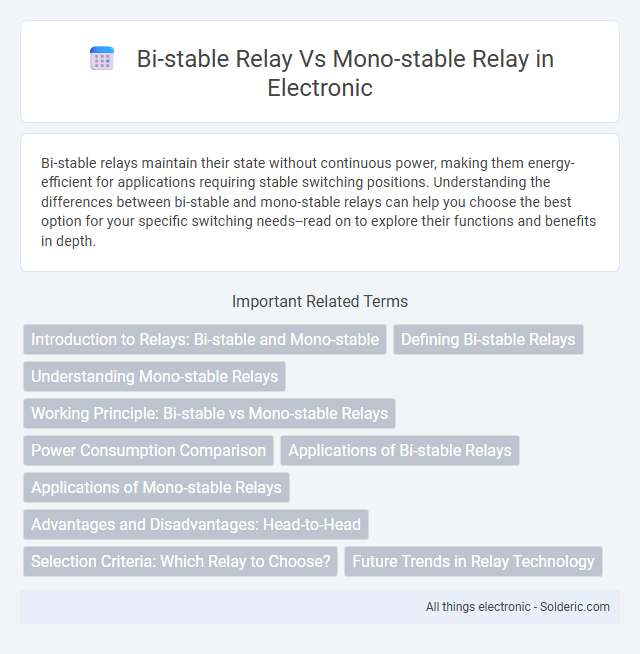Bi-stable relays maintain their state without continuous power, making them energy-efficient for applications requiring stable switching positions. Understanding the differences between bi-stable and mono-stable relays can help you choose the best option for your specific switching needs--read on to explore their functions and benefits in depth.
Comparison Table
| Feature | Bi-stable Relay | Mono-stable Relay |
|---|---|---|
| Definition | Relay that maintains its state after the coil is de-energized | Relay that returns to default state after coil is de-energized |
| Contact State | Two stable states (set/reset) | One stable state (normally open or closed) |
| Power Consumption | Consumes power only during switching | Consumes continuous power to maintain switched state |
| Applications | Memory storage, latching circuits, energy-saving switching | Timing circuits, impulse switching, safety interlocks |
| Switching Speed | Generally slower due to mechanical latching | Typically faster operation |
| Complexity | More complex with additional coil or mechanism | Simple design with one coil |
Introduction to Relays: Bi-stable and Mono-stable
Bi-stable relays maintain their position without continuous power, using magnetic latching to switch between two stable states, which enhances energy efficiency and reduces heat generation. Mono-stable relays return to their default state once power is removed, relying on a spring mechanism to change states momentarily during activation. These fundamental differences influence their suitability in applications requiring memory retention or temporary switching.
Defining Bi-stable Relays
Bi-stable relays, also known as latching relays, maintain their position after being actuated without needing continuous power, unlike mono-stable relays which return to their default state when power is removed. These relays use a magnetic or mechanical latch to hold the contact position, making them energy-efficient for applications requiring stable on/off states. Your choice of Bi-stable relays can significantly reduce power consumption in switching circuits while providing reliable state retention.
Understanding Mono-stable Relays
Mono-stable relays, also known as single-stable relays, maintain their default state until an external signal activates them, causing a temporary change in contact position. These relays automatically return to their original state once the activating signal is removed, making them ideal for applications requiring momentary switching or pulse control. Understanding mono-stable relays helps optimize their use in timer circuits, alarms, and push-button controls where you need precise, temporary activation.
Working Principle: Bi-stable vs Mono-stable Relays
Bi-stable relays operate using two stable states maintained by magnetic or mechanical latching, requiring power only during state changes, which enhances energy efficiency. Mono-stable relays rely on a spring mechanism to return to their default position once power is removed, making them suitable for temporary switching applications. The working principle of bi-stable relays ensures a sustained output without continuous power, while mono-stable relays need constant energization to maintain their active state.
Power Consumption Comparison
Bi-stable relays consume power only during state switching, as their magnetic circuit maintains relay positions without continuous current, leading to significantly lower energy usage compared to mono-stable relays. Mono-stable relays require continuous power to maintain the activated state, resulting in higher overall power consumption during operation. This energy efficiency makes bi-stable relays ideal for battery-powered or energy-sensitive applications.
Applications of Bi-stable Relays
Bi-stable relays are widely used in applications requiring energy-efficient switching and memory retention, such as lighting controls, automation systems, and smart meters where maintaining the relay state without continuous power is crucial. They are preferred in environments needing low power consumption combined with stable operation over long periods, including renewable energy setups and remote monitoring devices. The ability to sustain position after actuation makes bi-stable relays ideal for electric window lifts, HVAC controls, and industrial machinery that benefit from fail-safe or latched switching mechanisms.
Applications of Mono-stable Relays
Mono-stable relays are commonly used in timing circuits, pulse generation, and reset functions where a temporary change in state is required. They are ideal for applications such as motor starters, alarm systems, and lighting controls that need to return to their original state automatically after activation. Their quick response and single stable position make them suited for automation processes requiring momentary actuation.
Advantages and Disadvantages: Head-to-Head
Bi-stable relays maintain their position without continuous power, offering energy efficiency and reduced heat generation, but require a pulse signal for state change, complicating control circuits. Mono-stable relays return to a default state when power is removed, ensuring fail-safe operation and simpler control, but consume more energy due to continuous power needs when activated. Selection depends on application priorities: energy savings and memory retention favor bi-stable designs, while simplicity and default safety favor mono-stable relays.
Selection Criteria: Which Relay to Choose?
Bi-stable relays maintain their position without continuous power, offering energy efficiency and a stable switching state, ideal for applications requiring memory retention and low energy consumption. Mono-stable relays return to their default position once power is removed, making them suitable for temporary switching needs where constant power or momentary signals control operation. Your choice depends on whether your application demands sustained contact states with minimal power (bi-stable) or brief activation controlled by continuous power (mono-stable).
Future Trends in Relay Technology
Bi-stable relays, known for their low energy consumption due to maintaining state without continuous power, are driving future trends in energy-efficient automation and smart grid applications. Mono-stable relays, typically utilized for temporary switching, are evolving with faster response times and increased durability to meet demands in high-speed switching and automotive safety systems. Emerging trends include integrating IoT connectivity and advanced materials to enhance relay performance, reliability, and adaptability in both bi-stable and mono-stable technologies.
Bi-stable relay vs mono-stable relay Infographic

 solderic.com
solderic.com